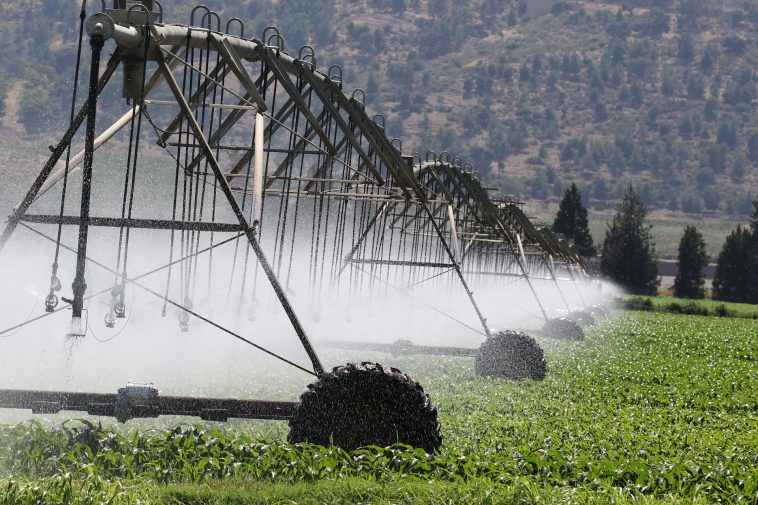60% of Africa is farmland. It represents a big stream of income for smallholder farmers and gross domes – tic product revenue for many African countries. In fact, agriculture contributes 23% to the continent’s GDP.
To ensure that the farmland is productive, dependence on rain for irrigation can be reduced by installing irrigation systems. Although irrigation in Africa has the potential to boost agricultural productivity by at least 50 percent, food production on the continent is almost entirely rain-fed. Currently, the area equipped for irrigation is barely thirteen million hectares — only six percent of the total cultivated area.
As more and more fields are irrigated, the use of automated irrigation systems cannot be overlooked. Auto – mated irrigation systems first appeared in July 1949 when Frank Zybach ap – plied for a patent on his ‘Zybach Self Propelled Sprinkling Apparatus’. Generally, Automated Irrigation Systems (AIS) work by continuously monitoring soil moisture content and wirelessly triggering pipeline valves to open when the moisture level falls below the minimum threshold for the cultivated crop.
Once the soil moisture content is above the maximum threshold, the system deactivates irrigation pipeline valves, which close and stop irrigation. The AIS is customisable and can also be used to upgrade existing drip irrigation systems, surface irrigation systems, and sprinkler irrigation systems to overcome their limitations.
Automation can be used to:
- Start and stop irrigation through supply channel outlets
- Start and stop pumps
- Cut off the flow of water from one irrigation area and direct the water to another area.
Benefits of automatic irrigation include:
- Reduction in labour costs
- Timely irrigation
- Improved management of water flow rates
- Precise cut-off of water compared to manual inspection
- Decreased run-off of water and nutrients plus reduced costs for vehicles used to check irrigation
Disadvantages of automatic irrigation are:
- The high costs for purchasing, installing, and maintaining the equipment
- Unreliability of the irrigation system due to lack of operational skills
- The increased maintenance of pipes, valves, and equipment to ensure it is working properly AIS can be categorised into four systems: pneumatic system; the portable timer system; the timer or sensor hybrid system, and the supervisory control and data acquisition (SCADA). The pneumatic system works through a permanent system activated by a bay sensor located at the cut-off point. As water enters the sensor, it pressurises the air, which is channelled to a mechanism that activates the opening and closing of irrigation structures. The portable timer system (PTS) is a provisional system that uses electronic clocks to activate the opening and closing of the irrigation structures. As the PTS is portable, four or five components are commonly acquired to move all over the place.
A timer or sensor hybrid system is one comprised of a hybrid of portable timer and sensor systems. Like a portable timer, it uses an automated device to trigger the opening and closing of the irrigation structures. This system has an additional feature of the irrigator being able to place a moveable sensor down the bay. When the moveable sensor comes in contact with water, it transmits radio signals to the timer devices at the outlets to open or close the structures. Afterwards, a radio message is sent to a receiver to let the landowner or farm manager know that the water has reached the cut-off points.
Supervisory Control and Data Acquisition (SCADA) comprises a personal computer and software package to schedule and control irrigation via a radio link. Signals are sent from the computer to control modules in the paddock to open and close irrigation structures with linear actuators. Bays are opened and closed according to set times. Some systems can automatically alter the time a bay outlet is open if the channel supply is inconsistent.
One feature of SCADA systems that distinguishes them from the other systems, is being able to start and stop irrigation pumps and motors. The application of AIS in SSA may seem far-fetched, but more and more farmers are becoming familiar with modern operational technologies by adopting the use of new efficient ways of operation to improve the financial performance of the farming enterprise. Thus, it will not be surprising to note an increased application of such systems.
Reference list:
Goedde, L., Ooko-Ombaka, A., Pais, G. (2019) Winning in Africa’s agricultural market. Available at: https://www.mckinsey.com/industries/agriculture/our-insights/winning-in-africas-agricultural-market
World Economic Forum (2022) How Africa can feed the world. Available at: https://www.weforum.org/agenda/2016/01/how-africa-can-feed-the-world/
AGRA (2022) Irrigation doubles African food production. Available at: https://agra.org/irrigation-doubles-african-food-production/
Frank Zybach (2022) National Inventors Hall Of Fame. Available at: https://www.invent.org/inductees/frank-zybach
AIS Technology. (2022) Smart Irrigation Solutions. Available at: https://aistechnology.mt/smart-irrigation-solutions/
Automation of Irrigation Systems and Design of Automated Irrigation Systems. Available at: https://www.eajournals.org/wp-content/uploads/Automation-of-Irrigation-Systems-and-Design-of-Automated-Irrigation-Systems.pdf
Agriculture Victoria (2022) Automated Irrigation. Available at: https://agriculture.vic.gov.au/farm-management/water/irrigation/automatic-irrigation
Morgana, S. (2020) Why use SCADA for your irrigation systems. Available at: https://www.dpstele.com/blog/why-usescada-for-your-irrigation-systems.php









